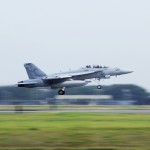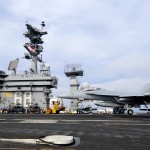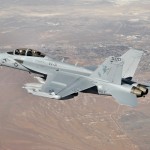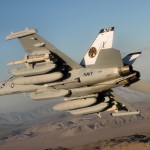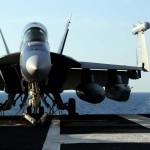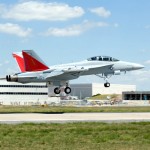
The venerable Grumman A-6 “Intruder,” first flown in 1960, has had a long life, partially thanks to the EA-6B electronic warfare variant, which is still in service today aboard American carriers.
When that career finally comes to an end, it will be the EA-18G “Growler” that takes over. A variant of the two-seat F/A-18F “Super Hornet,” the Boeing EA-18G entered service in 2009 and has been taking over for the EA-6B ever since. Nearly 100 have been built and more than double that are on order as of 2012.
In 2001, Boeing demonstrated the effectiveness of the ALQ-99 electronic warfare pod fitted to a “Super Hornet.” By 2006, there was much debate about whether the U.S. Navy should invest in a brand new electronic warfare plane or continue to upgrade the tried and true EA-6B. In the end, the modern and advanced capabilities of the “Growler” won out.
The “Growler” is not a traditional fighter. It’s not going to strike runways or seek our air-to-air dogfights, though it can hold its own in the latter. The plane is designed along the Navy’s mission of jamming and electronically fighting the enemy, which is opposed to the Air Force’s preference for stealth. (The Navy has never had a stealth airplane.) An EA-18G will carry a variety of equipment including jamming pods, AIM-120 “AMRAAM” and AGM-88 “HARM” missiles and communication blocking equipment. It will fly SEAD missions against enemy air defenses, wiping out AAA and SAM sites with the “HARM” missiles or provide escort for other planes, jamming any threats that come up.
The AN/ALQ-99 jamming system is the same one featured on the EA-6B and it was carried on the older EF-111A, which has been retired since 1998. It has been used since Vietnam. The system is effective against known threats, but there is a movement to replace it and a fear that it will not be effective against future threats. The ALQ-99 also interferes with the EA-18G’s radar, slows the plane down, and requires a lot of input from the flight crew.
The EA-18G is virtually identical to the F/A-18F, and that is intentional. The “Growler” is designed to grow and evolve with the “Super Hornet,” with the same emerging weapons and systems being ported to both platforms.
The “Growler” has become a vital piece in the Pentagon’s arsenal. In 2009, according to Wired magazine, the Defense Department opted to buy more EA-18Gs instead of more F-22 fighters as it plans to introduce a “Next Generation Jammer” that could have to go up against modern Chinese or other nations’ fifth and future generation fighters. The Wired piece also states that the EA-18G can remotely insert viruses into enemy computer networks and missile sites, a tactic that Israel is believed to have used against the Iranian nuclear program multiple times.
Specifications
General
Crew: Two
Length: 60 ft 1.25 in
Wingspan: 44 ft 8.5 in
Height: 16 ft
Empty weight: 33,094 lb
Max takeoff weight: 66,000 lb
Engines: Two General Electric F414-GE-400 turbofans with 14,000 lbf each
Performance
Maximum speed: Mach 1.8
Combat radius: 449 mi
Ferry range: 2,070 mi without ordnance
Ceiling: Above 50,000 ft
Thrust/weight: 0.93
Armament
Missiles: Two AIM-120 “AMRAAM” and two AGM-88 “HARM” missiles
Electronic Warfare: AN/ALQ-99 jamming pods and AN/ALQ-218 detection pods
Essential Reading and More
Online Resources:
- Wikipedia
- Boeing — Official site
- Naval Air Systems Command — Official Navy site, great info and photos
- naval-technology.com — Good info
- VAQ-141 Shadowhawks — Amazing photos
- Wired: New Navy Jammer Could Invade Networks, Nuke Sites, January 21, 2011
